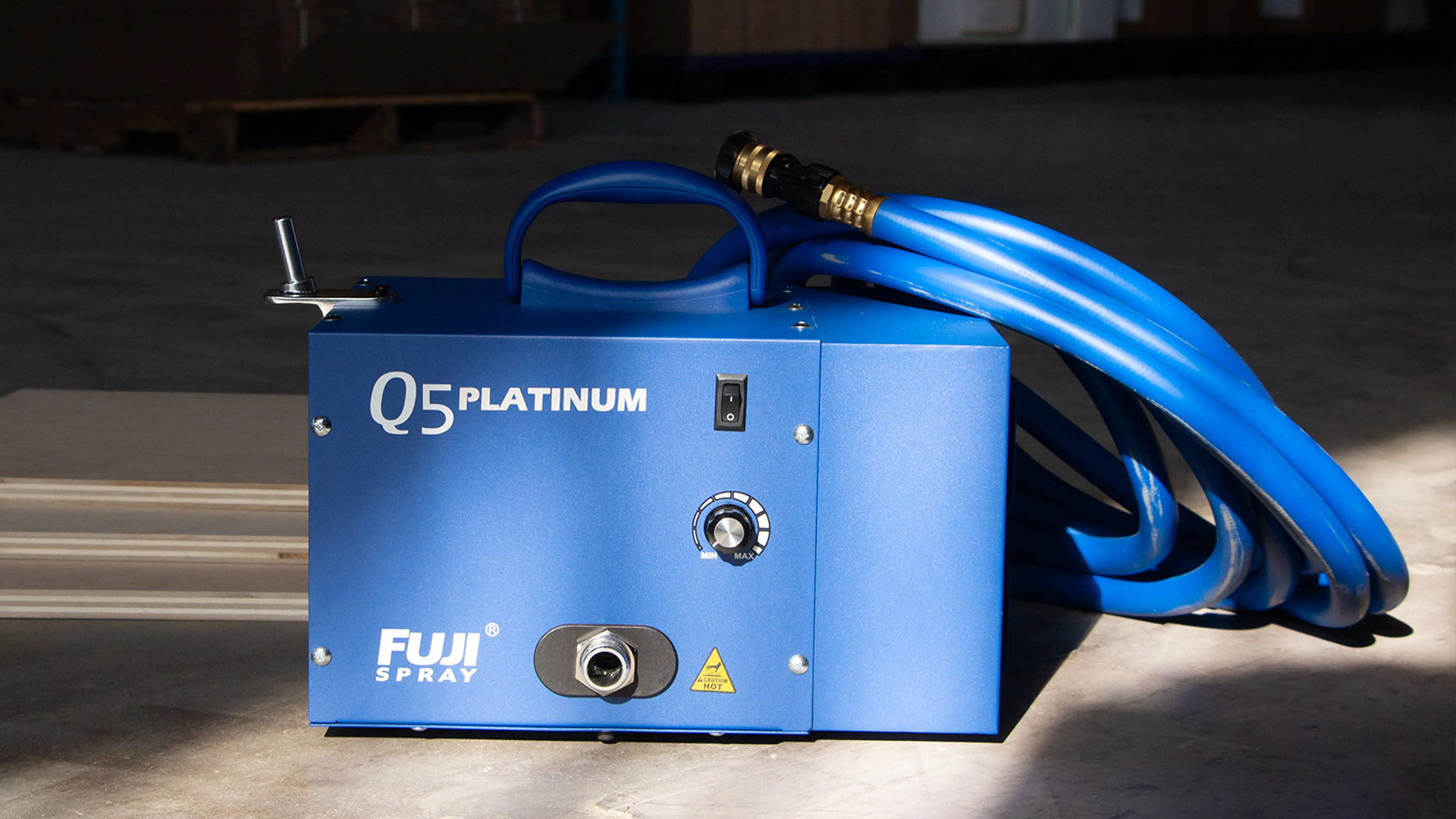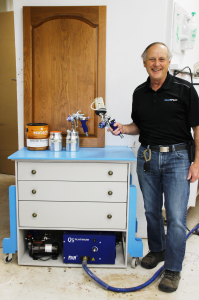
In the Market for HVLP? Considerations!
You know the drill. You’ve poured your heart and soul into designing and crafting a piece of quality furniture and are excited with how things are coming along. But, like many, you’re dreading the next and final stage: finishing. Sure, you could rub on some shellac or a hard wax oil finish and be done with it, but you know that neither are durable enough to stand up over the long run. After all, wasn’t it your objective to make something you’d be proud to pass along to future generations? That’s where sprayed finishes come in. They’re highly durable, fast drying, look terrific and in the case of water-based finishes, gentle on the environment. And with HVLP spray finishing systems now costing far less than half the average circular saw, coupled with spray finishing’s relatively easy learning curve, it’s easy to see why spray finish technology has become so popular among woodworkers at all skill levels.
So here’s a few things to take into consideration when picking out an HVLP turbine system, starting first with the turbines themselves:
 What size Turbine do I need?
What size Turbine do I need?
Turbines are rated by the number of stages (sets of fans) they have; the more stages, the more air pressure they generate. That having been stated, all Fuji Spray®’s systems deliver a great finish when spraying those general finishes most woodworkers use. These “thinner” finishes (e.g. stain, lacquer, varnish and urethane) can be sprayed just as they come out of the tin, with no thinning whatsoever required. But if you are planning to primarily spray “thicker” finishes (e.g. latex paint or tinted lacquer) which require some degree of thinning, consider getting a 4 or 5-stage turbine. And because of the increased pressure those turbines produce, that advantage also makes them a good choice for anyone contemplating finishing high volume projects such as kitchen cabinets – because you can lay down more finish with each pass.
What’s the Difference between Fuji Spray®’s Three Turbine HVLP Series?
With that groundwork laid down, let’s look more closely at the three systems. First off is the entry level DIY-PRO™ series, which is offered with a great starter gun unique to this series. With its 2-stage turbines generating 5 PSI, this series is an excellent choice for the more budget-conscious finisher. Next in line is the Mini-Mite Platinum™ series, which is offered in either a 3, 4 or 5-stage turbine package. These impressive turbines, featuring the Fuji Spray® Heat Dissipation Chamber™ to extend the turbine lifespan compared to standard turbines, generate 6.5, 9 and 9.5 PSI, respectively. Buyers may choose one of two HVLP spray guns: the unique swivelling-cup G-XPC model and the newer, lighter T-series model. These spray guns all feature Fuji Spray®’s unique side-mounted Fan Pattern Control™, giving comfortable, quick and precise adjustments all at your fingertips. And for those of whom noise is a primary consideration, the Q Platinum™ series, with its patented noise-reduction technology is offered. This series also features the Fuji Spray® Heat Dissipation Chamber™, and is offered in either a 3, 4 or 5-stage turbine package generating 6.5, 9 and 9.5 PSI respectively. You’ll have your choice of either the aforementioned G-XPC or T-series HVLP spray gun models. But there’s another unique feature worth mentioning: the Q5 Platinum™ unit’s variable-speed turbine motor, enabling you to dial in the air volume that best meets the finishing task at hand.
As if that’s not enough information to consider when choosing the best HVLP turbine system to meet your requirements, here’s a few additional add-ons I recommend for customizing your spray finishing setup and making your spraying sessions more efficient and enjoyable:
- Wireless Turbine Remote. This slick accessory enables you to remotely start/stop your turbine from a distance. This not only saves you time and extends the life of your turbine but encourages you to properly position your turbine well away from your spraying area, in turn keeping your turbine filters clean.
- Spare Turbine Filters. This allows you to continue spraying while waiting for a freshly washed one to dry. Note that some turbines have two filters and that each series has it own style filter.
- Gravity Feed Gun Holder. I consider this an absolute necessity, as how else are you going to hold your gravity feed gun for filling?! And to keep all your turbine guns at hand, I find the Handy Gun Holder to be quite handy (sorry about the pun… but it truly is handy).

- Whip hose. Adding this highly flexible, 6’ hose to the end of your 25’ air hose will make it easier and more comfortable for you to maneuver your spray gun.
- Air Cap Sets. By changing out your air cap set, you’ll be able to dial your spray gun in to suit the finish you’re about to spray. The “heavier” the finish, the larger size air cap set required.
- Spray cups. Although having a large spray cup enables you to carry more finish, when you need to get into confined spaces (inside a small cabinet…) a smaller spray cup can make your life a lot easier. And some individuals prefer metal to nylon cups… and vice-versa. For these reasons, Fuji Spray® offers several choices to allow you to customize your HVLP spray gun. Check them out. Oh, and speaking of spray cups, if you have a bottom feed gun, you’ll want to get a set of caps. Very convenient accessories!
- Pressure Pot. If large tables or high volume spraying (think: kitchen cabinets…) are on your next project list, you should consider getting a 2-quart pressure pot. This significantly lightens the load on your arm by relocating the finish to a high-volume pot you can either set on the ground or carry conveniently in a backpack (I kid you not!). Note that this muscle-saving system will work only with a 4 or 5-stage turbine.
- 3M™ PPS™ System Adapter. With this adapter, T-series spray gun users can use the 3M™ PPS™ system. PPS is an extremely attractive option for those whose work requires plenty of in-cabinet and under-surface spraying, as it enables you to spray at any altitude, even upside down. It also reduces spray gun cleaning time and makes swapping out various finishes more efficient. And left-over finish needn’t be returned to the tin, but once removed from the spray gun, may be capped off and put away for use later. Very efficient.
- A Second Spray Gun. For those who spray both water-based and oil-based finishes, or whose spraying sessions include a variety of different finishes all the time, having a second spray gun can be a great investment.
Now that I’ve covered the bases on the various turbines, spoken about the various spray guns available and thrown out a whole hockey sock of ideas on accessories for customizing your spray finishing experience, I suppose you’ve got HVLP spray finishing systems figured out, right? Well… kinda. In a future article I’ll introduce you to the world of air compressor HVLP spray guns, which for those who already own a mid to high-performance air compressor, they may wish to consider looking at them.
Until then, good luck with your spray finishing!
Marty


